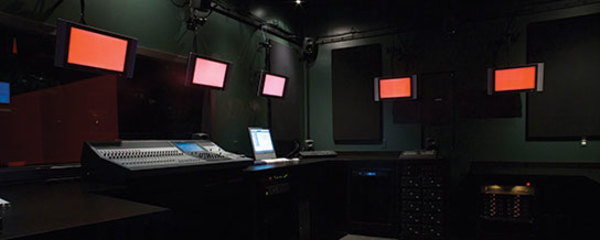Aspohdel’s Bold Control Center
One day, this too will all be obsolete. Why? Because San Francisco’s Recombinant Media Labs–built […]
Aspohdel’s Bold Control Center
One day, this too will all be obsolete. Why? Because San Francisco’s Recombinant Media Labs–built […]

One day, this too will all be obsolete. Why? Because San Francisco’s Recombinant Media Labs–built by Asphodel label heads and industrial music experimenters Naut Humon and Mitzi Johnson–puts into question everything you’ve ever thought possible about composing, recording, and performing electronic art. And in the years to come, they’ll likely top themselves again.
Housed in a non-descript warehouse building in San Francisco’s South of Market district, RML (which also encompasses the Asphodel label office) is comprised of an unprecedented 16.8.2-channel, 10-screen surround-cinema performance environment with an external control room, an acoustic performance space with a grand piano, a suite full of synthesizers new and old, a DVD- and CD-mastering studio, and a full-on recording studio with all the bells and whistles of current and bygone eras. But, as Humon says, it’s not the technology that drives RML: “It’s the people.” Based on a model that enables the music community at large, Humon and participating artists (from Jarboe of Swans to Thomas Brinkmann) privately seek grant monies to sponsor their performances and residencies. Artists rarely clock in for the day. Instead, they often spend weeks at a time at the studio, collaborating and creating site-specific musical and visual works.
Today, British sound sculptors Semiconductor are in the studio’s master control room, chatting with Australian electronic art curator Paul Thomas and sound designer Nigel Helyer while putting the finishes touches on a multimedia piece that sonically interprets the sun’s radiation. They’ll later perform it as part of San Jose’s International Symposium on Electronic Art. Tomorrow, the room’s booked for Ryoji Ikeda, who has composed an audio-visual piece that he’ll present while looking in from the outside of the RML’s state-of-the-art listening environment.
Join Naut Humon as he presents us with a glimpse of one of electronic art’s finest facilities ever.
Synth Room
Here is an analog haven where artists can come in and grab sounds for their work. It’s all based around hard and soft synths from the past and present, starting from the ’70s when I used this SMS Salamander modular synthesizer with joysticks, oscillators, thumbwheels, and all kinds of custom modules like the Outside World Interface. There’s also a nine-panel Serge Modular System, which interfaces to the MiniMoogs, drum machines, a full-blown KYMA Capybara computation engine and every type of software synthesizer, so you can play the room like one giant machine. Florian Hecker was here for days just plugging things in, and he used the source material during his residency for a live event.
Video- and DVD-Editing/Authoring Suite
This spot is where AV editors from the community can weld together visual and audio source material into a coherent piece; the model here is building a bridge between cultural and commercial style jobs. The first client here was Lou Reed, who played a new version of Metal Machine Music transcribed and performed by a group named Zeitkratzer from Berlin–an 11-piece group of brass, strings, and percussion–and the inside of a piano; they documented the live concerts of MMM in Berlin and brought the results back to mix and edit with Lou and some of his people.
The Surround Traffic Control Room
This is a spatial-media-synthesis (or surround-cinema) model for all sizes of rectangular rooms in the world. We chose a 10-screen format–with three screens on each wall and two on each end–but of course this can be scaled down or up, because most global media festivals have only one to four big screens. The panoramic screens are linked to 16 audio channels–eight near the ceiling and eight near the ground, so you can project horizontal, vertical, or diagonal sound trajectories in the X, Y, or Z axes. For multi-channel video, we have 10 DVD players that can all be synchronized together, or real-time video signals can directly emanate from numerous desktop or laptop computers.
The Recombinant Media Labs Performance Theatre
This is our larger acoustic-treated space; our main 360-degree periphonic cinema hub, which the smaller STC control room emulates. The audiences that enter are immersed from all sides by the network of high-resolution screens and speakers. They are welcome to stand, sit, or move around according to the performer’s plan, which can optionally include installation- or exhibition-style setups. As experiential engineers, we archive the full impact of the entire production for future playback screening scenarios. This includes the ability to sculpt even the bass frequencies in the unusual formations of eight added sub-low channels, which augment the full-range, circular, 16-speaker array. Couple this with a stereo Infra sub-wave front for a deeper “point-two,” and 32 transducers under the floor, and you have a 16.8.2 PA matrix with configurable crossovers. A fascinating research and “envelopment” environment for the inter-media navigator!
Asphodel Studio’s Main Mix A
This chamber represents a hybrid of a sound-to-picture suite and an audio recording and mixing apparatus. The primary feature is a Neve VR-72 console, which dates from around ’93, during the last generation of the bigger analog boards. We had Madlabs in L.A. hot-rod it to 2006 specifications. For monitoring, we utilize two sizes of PMC speakers along with a Dynaudio 5.1 system for broadcast and film audio surround. There are extensive racks of vintage and recent hardware processor equipment for all forms of dynamics applications, including tube and optical technologies. Add to that a powerful Pro Tools system and analog tape machines, as well as all the platforms of DP, Logic, Nuendo, Max/MSP, Supercollider, and PD for full compatibility with home preparation studios.

